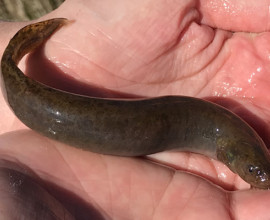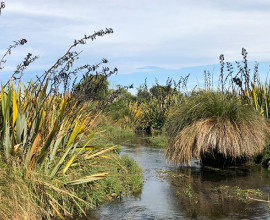Kōwaro - Canterbury Mudfish
Kōwaro (Canterbury mudfish) are the most threatened of New Zealand's mudfish species. They have a conservation status of Threatened (Nationally Critical) under the NZ Threat Classification System.
They are found in a limited number of waterways in the Canterbury Plains, between the Ashley River (in the north) and the Waitaki River (in the South).
The map below shows records of kōwaro habitat from NIWA’s New Zealand Freshwater Fish Database – you can find more information here.
There are distinct clusters in the records for kōwaro habitat. These hotspots relate to where large inland and coastal wetlands were before European land development.
If you live in one of these areas, you could possibly have mudfish on your property.
The populations are now highly fragmented, and mudfish can occur in small pockets of habitat. It’s likely that not all of these have been found.

There is little, if any, unmodified habitat left and it is difficult to say what mudfish (kōwaro) would have preferred. Maybe it was pools within boggy kahikatea forests, or thick flax swamps, or maybe amongst the sedges and rushes around groundwater springs.
Today, kōwaro are found in a wide range of places, from small springs, wetlands and willow bogs to more modified habitats such as water races, roadside drains and farm ponds; basically, any suitable aquatic habitat that is left.
General characteristics of mudfish habitat
What most habitats have in common is that water flow is slow or absent. Aquatic plants also grow well in these habitats and there may be more silt than cobbles present.
However, there are many habitats that look suitable, but mudfish are not present because they dry out too much or there are too many eels or other fish species.
Adult mudfish (kōwaro) are only active at night so are rarely seen. However, their young actively forage out in the open in the water for about a month until they are around 30–40 mm long. These young fry can be seen during spring and early summer and look like small, dark-coloured, wiggly whitebait.
Spotting mudfish
To spot them, you need to spend several minutes looking carefully through the water at several locations. Still, sunny afternoons are the best time to look as the water surface is calm and sunlight helps; it is often easier to spot the moving shadow of the small, semi-transparent fish.

There are other common native species that have similar looking fry so if you spot something, contact your local DOC office as they have several mudfish experts who can help check which species is present by catching some adults, as well as offering broader advice and support.
Once you know you have mudfish, you can look for fry each year to check they are still present and reproducing. This would be important to do after droughts or if you were making changes that might affect their habitat.
Congratulations! The persistence of mudfish (kōwaro) indicates that responsible land and water management has been practised. Maintain the status quo as much as possible, especially if mudfish are thriving.
Protecting Mudfish habitat
However, if changes to land or water-use are planned, then options for protecting habitat may need to be considered. General guidelines for managing waterways on farms may apply.
Except that sometimes the opposite guidelines may apply! Mudfish habitats don’t need to be heavily shaded with trees and shrubs as recommended for other species or larger streams. Also avoid planting deciduous trees as their leaves may overload small habitats and ponds.
Downstream barriers to fish, such as overhanging or badly installed culverts, may protect mudfish habitat by preventing other fish (that might prey on mudfish) from invading upstream.
Aquatic plants, even those considered weeds, are important for mudfish (kōwaro) as cover from predators and to lay their eggs on. It is important to clear out aquatic plants in autumn, and avoid doing so during late winter and early spring, when they might be covered with tiny, transparent mudfish eggs. Doing so could remove an entire generation!
Try to leave areas that are not problematic; every small patch of plant cover matters. Ideally, water should flow freely and there should be plenty of plants growing in the water along the bank edge.
If you have now joined the growing list of people who are passionate about the Canterbury mudfish (kōwaro), you may want to consider these actions.
As an individual you can:
- become a member of a Resource Care group, or form a new one if one does not exist in your area;
- donate money to habitat restoration programmes; and
- attend a working bee at a nearby restoration activity.
As a company or organisation you can:
- sponsor specific habitat restoration programmes;
- donate money to habitat restoration programmes or larger government-backed schemes;
- offer suitable products or materials to assist with biodiversity programmes (eg, weedmatting, native plants, spades and shovels, fencing materials); and
- organise your staff for working bees on a nearby restoration programme.
Depending on the nature of your interest and your objectives, you may be able to get funding to help restore mudfish habitat.
If you are a community organisation or a landholder, you should consider these sources of funding:
- New Zealand Biodiversity Strategy (NZBS) funded programmes
- Ministry for the Environment’s Community Environment Fund
- Pacific Development and Conservation Trust
- Funding for community groups and landowners (DOC info)
- 50 facts about Canterbury Mudfish – written by Dr Leanne O’Brien, one of the key scientists researching mudfish habitats in Canterbury
- The conservation ecology of Canterbury mudfish – Leanne O’Brien, as above
- Mudfish facts – Department of Conservation
- Biodiversity guidance for private land – Department of Conservation





